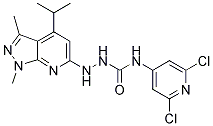This product is for research use only, not for human use. We do not sell to patients.

| Size | Price | Stock |
|---|---|---|
| 5mg | $98 | 3-6 Days |
| 10mg | $150 | 3-6 Days |
| 25mg | $250 | 3-6 Days |
| 50mg | $400 | 3-6 Days |
| 100mg | $650 | 3-6 Days |
| 250mg | $1100 | 3-6 Days |
| 500mg | $1750 | 3-6 Days |
Cat #: V2754 CAS #: 547756-93-4 Purity ≥ 98%
Description: JTE 013 (JTE-013) is a novel potent and selective S1P2 (sphingosine-1-phosphate 2) antagonist with IC50 of 17.6 nM. It binds to the human and rat receptors with IC50 values of 17 and 22 nM, respectively, and with IC50 values >10 µM for human S1P1 and S1P3. It reverses the inhibitory effects of S1P2 signaling on cell migration of vascular ECs and smooth muscle cells. It also regulates endothelial tight junctions and barrier function in vitro. Blockage of S1P2 signaling by JTE-013 significantly enhances the effects of S1P on the increase of TEER, an in vitro measurement of endothelial integrity, as well as the formation of TJs in senescent ECs.
Publications Citing InvivoChem Products
Product Promise

- Physicochemical and Storage Information
- Protocol
- Related Biological Data
- Stock Solution Preparation
- Quality Control Documentation
| Molecular Weight (MW) | 408.29 |
|---|---|
| Molecular Formula | C17H19Cl2N7O |
| CAS No. | 547756-93-4 |
| Storage | -20℃ for 3 years in powder form |
| -80℃ for 2 years in solvent | |
| Solubility In Vitro | DMSO: 81 mg/mL (198.38 mM) |
| Water: <1 mg/mL | |
| Ethanol: 34 mg/mL (83.27 mM) | |
| Solubility In Vivo | CC(C1=C2C(N(C)N=C2C)=NC(NNC(NC3=CC(Cl)=NC(Cl)=C3)=O)=C1)C |
| Synonyms | JTE-013; JTE 013; JTE013. |
| Protocol | In Vitro | In vitro activity: JTE-013 reverses the inhibitory effects of S1P2 signaling on cell migration of vascular ECs and smooth muscle cells. It also regulates endothelial tight junctions and barrier function in vitro. Blockage of S1P2 signaling by JTE-013 significantly enhances the effects of S1P on the increase of TEER, an in vitro measurement of endothelial integrity, as well as the formation of TJs in senescent ECs Kinase Assay: JTE 013 is a novel potent and selective S1P2 (sphingosine-1-phosphate 2) antagonist with IC50 of 17.6 nM. It binds to the human and rat receptors with IC50 values of 17 and 22 nM, respectively, and with IC50 values >10 µM for human S1P1 and S1P3. It reverses the inhibitory effects of S1P2 signaling on cell migration of vascular ECs and smooth muscle cells. It also regulates endothelial tight junctions and barrier function in vitro. Blockage of S1P2 signaling by JTE-013 significantly enhances the effects of S1P on the increase of TEER, an in vitro measurement of endothelial integrity, as well as the formation of TJs in senescent ECs. Cell Assay: HUVECs preincubated with various concentrations of JTE-013 for 10 min are allowed to migrate for 4 h toward the lower chamber where the indicated concentrations of Sph-1-P are placed. The migrated cells on the lower side of the filter are fixed, stained, and counted. |
|---|---|---|
| In Vivo | JTE-013 inhibition of S1P2 significantly inhibits microvascular permeability in an in vivo animal model. It modulates the responses of brain endothelium by inhibiting cerebrovascular permeability, the development of intracerebral heamorrhage, and neurovascular injury in an experimental model of stroke. JTE-013 reduced mast cell activation, airway infiltration, and the serum levels of histamine and several cytokines in vitro and in vivo studies. In a murine model, JTE-013 suppresses streptozotocin-induced blood glucose increases, pancreatic b cell apoptosis, and the incidence of diabetes. In a New Zealand obese diabetic mouse model under high-fat diet conditions, it protected pancreatic b cells. Treatment with JTE-013 also reduces plasma levels of IL-1b and IL-18 (endotoxin-induced inflammatory cytokines) in ApoE−/− mice and S1P2 gene deficiency reduces atherosclerosis. The compound offers a novel means of treating inflammatory disorders, such as, atherosclerosis and sepsis. | |
| Animal model | Mice(C57BL/6×129Sv genetic background) |
| Solvent volume to be added | Mass (the weight of a compound) | |||
|---|---|---|---|---|
| Mother liquor concentration | 1mg | 5mg | 10mg | 20mg |
| 1mM | 2.4492 mL | 12.2462 mL | 24.4924 mL | 48.9848 mL |
| 5mM | 0.4898 mL | 2.4492 mL | 4.8985 mL | 9.7970 mL |
| 10mM | 0.2449 mL | 1.2246 mL | 2.4492 mL | 4.8985 mL |
| 20mM | 0.1225 mL | 0.6123 mL | 1.2246 mL | 2.4492 mL |
This equation is commonly abbreviated as: C1 V1 = C2 V2
- (1) Please be sure that the solution is clear before the addition of next solvent. Dissolution methods like vortex, ultrasound or warming and heat may be used to aid dissolving.
- (2) Be sure to add the solvent(s) in order.




































